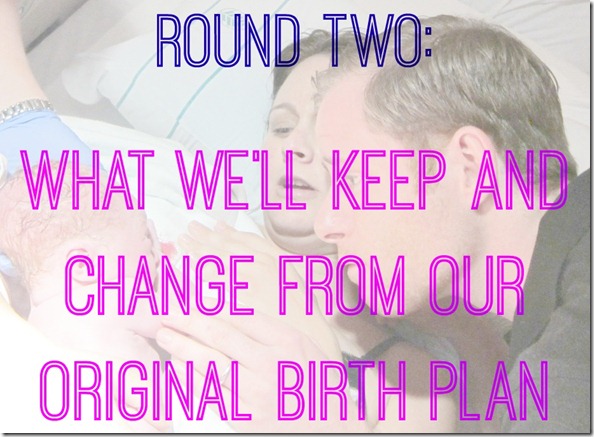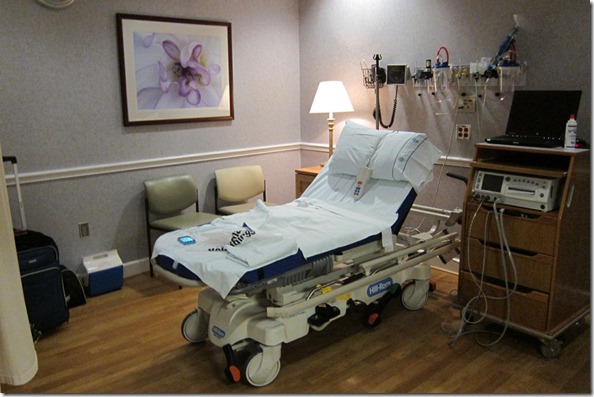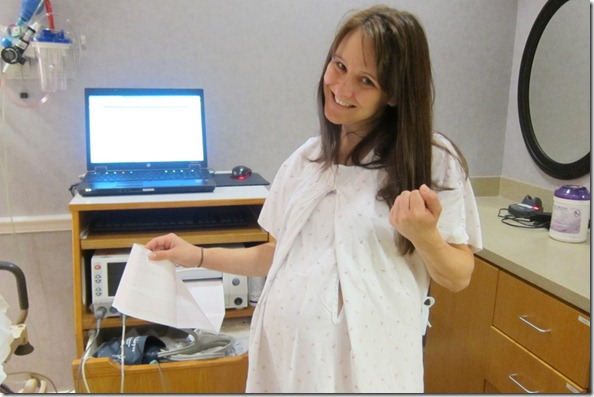When I was pregnant with Henry, I wrote a lot about my plans for a drug-free birth. Some people said to me, “You can’t plan birth! What’s going to happen is going to happen!†That’s true. You can’t really plan birth. But I do think that preparation can really pay off, especially if you’re hoping for a birth with minimal interventions.
A side note: Other people said to me, “The birth experience doesn’t matter! All that matters is a healthy baby!†I don’t think this is entirely true. Of course, the number one priority is a healthy baby and healthy mom. But the birth experience matters, too. It’s a huge life moment and a major medical event. Is it everything? No, definitely not. But I believe that it does matter to many women – and it’s okay to feel like it matters.
So yes – you can’t totally plan a birth. And you can’t predict many parts of labor. But it was very helpful for me – emotionally and logistically – to study the Bradley Method of childbirth and write a birth plan before I delivered my first child. It really helped me understand what would happen in my ideal birth scenario, what would happen if things didn’t go to ‘plan,’ and helped me generally prepare emotionally for childbirth. Stress and fear of the unknown can truly stall or undo labor, so it’s great if you can stay as calm as possible. I think ALL moms could benefit from writing out a birth plan – it’s not just for those wanting to go drug-free!
Our Original Birth Plan
Practically speaking, we kept our birth plan as short as possible and used bullets to make it easy to read. I think this is really important – I’ve seen plans online that are three to four pages long. That’s too long for someone else to quickly read and digest.
When I was preparing to write this post, I asked the Husband about how sharing the birth plan with the nurses went down (my midwife already had a copy). I had no recollection of this part of birth – making sure the nurses read the plan was my Husband’s job. He said that he made sure he was very polite as he gave a copy to each nurse that entered the room. He waited for the nurse to look over it and then asked if they had any questions. He says one of the nurses also taped a copy to the door of the room.
Per Bradley Method teaching, Kristien also reminded the midwife and nurses of our wishes at key moments. For example, it’s standard procedure at our hospital to clamp the umbilical cord pretty quickly, but we wanted to do delayed clamping. He said that he reminded them of this right as Henry was being born.
What We’ll Keep and Change This Time Around
KEEP – Just like before, at the top of the plan will be a BIG REMINDER – We do NOT know the sex of the baby! Kristien would like to announce the sex to Caitlin. Please do not spoil the surprise! <— This was AMAZING!
CHANGE – Overall, the new plan will be shorter. We put a few post-birth items on the plan that the hospital staff needed our written permission to do/not do – these line items were unnecessary and just made the plan longer.
KEEP – A blurb about how we want a medication-free labor and how I would prefer not to be offered drugs no matter how I’m acting emotionally. We’ll also keep the bit about how, if the staff believes interventions are necessary, it should be discussed with my husband first – not with me.
CHANGE – We had a line about not wanting the pushing directed by counting or yelling. Also another line about keeping the lights dim. Honestly, in hindsight, these requests were kind of ridiculous/a first-time-mommy kind of thing. And I mean that in the nicest way possible to my former self! Hah. The reality is that I didn’t give a shit that my midwife counted out loud during my contractions and hell if I noticed the lights were on or off. The bottom line is that if someone/something was hindering my performance, I could’ve just said something in the moment – it didn’t really need to go on the plan.
KEEP – We’ll also keep our wishes that are NOT standard operating procedure for the hospital, such as the information about not clamping or cutting the cord immediately.
KEEP – The blurb about not giving the baby a bath immediately and not removing the baby from me for immediate testing (barring medical issues, of course). Henry didn’t get weighed or measured for at least an hour after birth, and he didn’t get a bath for much longer. I wanted to do skin-to-skin as long as possible; my hospital supports skin-to-skin but I’m pretty sure that it’s standard to do the testing off mom and pretty quickly.
KEEP – The blurb about not throwing away my placenta because I plan to encapsulate it again.
CHANGE – When I originally wrote the plan, my midwife looked it over and we discussed it. But I should’ve had her cross out stuff that she wouldn’t do anyway / the hospital wouldn’t do unless there was a major medical need. For example, I wrote that I didn’t want an episiotomy. They don’t do them regularly/preemptively at my hospital anymore, so that was redundant. Side note – I ended up getting one, but I needed one.
In Conclusion…
If you want to write a birth plan, here are some things that I think you should consider, based on my first birthing experience:
1) Who is going to ensure that medical staff actually read the plan? How many copies should you bring to the hospital?
2) What can you cut from your plan to make it as short and easy to read as possible? Ask your doctor or midwife to look it over.
3) Did you say THANK YOU at the top of the plan? Because you should! I cannot say enough great things about birthing staff – they work SO hard and for SO long. One of my nurses even stayed HOURS over her shift to help me get through the end… amazing!
4) Have you talked to your doctor/midwife/childbirth educator about the pros and cons of potential interventions? I think it’s helpful to educate yourself and your birth partner in advance so you can better understand medical advice. I really believe in finding medical professionals you trust and respect, but it’s helpful to be a knowledgeable (but not a know-it-all!) patient, too.
5) If you’re aiming for a drug-free birth, consider whether or not you want to be brought into discussions about (non-emergency) interventions immediately or not. Do you want to designate yourself as the ‘point person’ or do you want to put that responsibility in someone else’s hands (at least initially)? Or do you want be that person? Personally, I wanted my husband to run interference/make basic decisions so I could keep my head in the game as long as possible.
So – those are my thoughts on having a birth plan! Like I said, I think birth plans get a bad rap, but as long as you go into the experience knowing that it’s really just part of preparing for birth and a general guide for medical staff in your ideal birth scenario, writing a plan can be a great thing.
Did you write a birth plan? What advice do you have for other moms who want to write one?
For more:
My review of the Bradley Method (pre-birth and post-birth)




I’m lecturing on prenatal development and birth next week in class so I may use this as an example of a birthing plan! Most of my students are fairly young (first year college) so they don’t even know that birthing plans exist. Always love to see their faces when I talk about eating the placenta 🙂